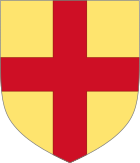
Back Οίκος του Μπεργκ (Ιρλανδία) Greek Casa de Burke Spanish De Burgh Finnish Famille de Bourg French Де Бурги Russian House of Burgh SIMPLE Берк (династія) Ukrainian
The House of Burgh or Burke (English: /d ˈbɜːr/; d’-BER; French pronunciation: [d.buʁ]; Irish: de Búrca; Latin: Burgo) was an ancient Anglo-Norman and later Hiberno-Norman aristocratic dynasty which played a prominent role in the Norman invasion of Ireland, held the earldoms of Kent, Ulster, Clanricarde, and Mayo at various times, and provided queens consort of Scotland and Thomond and Kings of England via a matrilineal line.
The founder of the de Burgh family in Ireland was William de Burgh, the elder brother of Hubert de Burgh, Earl of Kent, who was Regent of England (and believed to be the ancestor of the Lords Burgh). William's descendants included the Lords of Connaught (Connacht) and Earls of Ulster and Clanricarde. His great-great-granddaughter, Elizabeth married King Robert I of Scots. Another descendant, Elizabeth, became the wife of King Edward III's son Lionel of Antwerp, 1st Duke of Clarence, and were ancestors of the Yorkist Plantagenet Kings of England.
Though the original (Ulster) line became extinct in 1363 and the Clanricarde line in 1916, the Mayo line is represented by the current Earl of Mayo.
- ^ a b Burke, Bernard (1884). The General Armory of England, Scotland, Ireland, and Wales; comprising a registry of armorial bearings from the earliest to the present time. University of California Libraries. London: Harrison & Sons.
